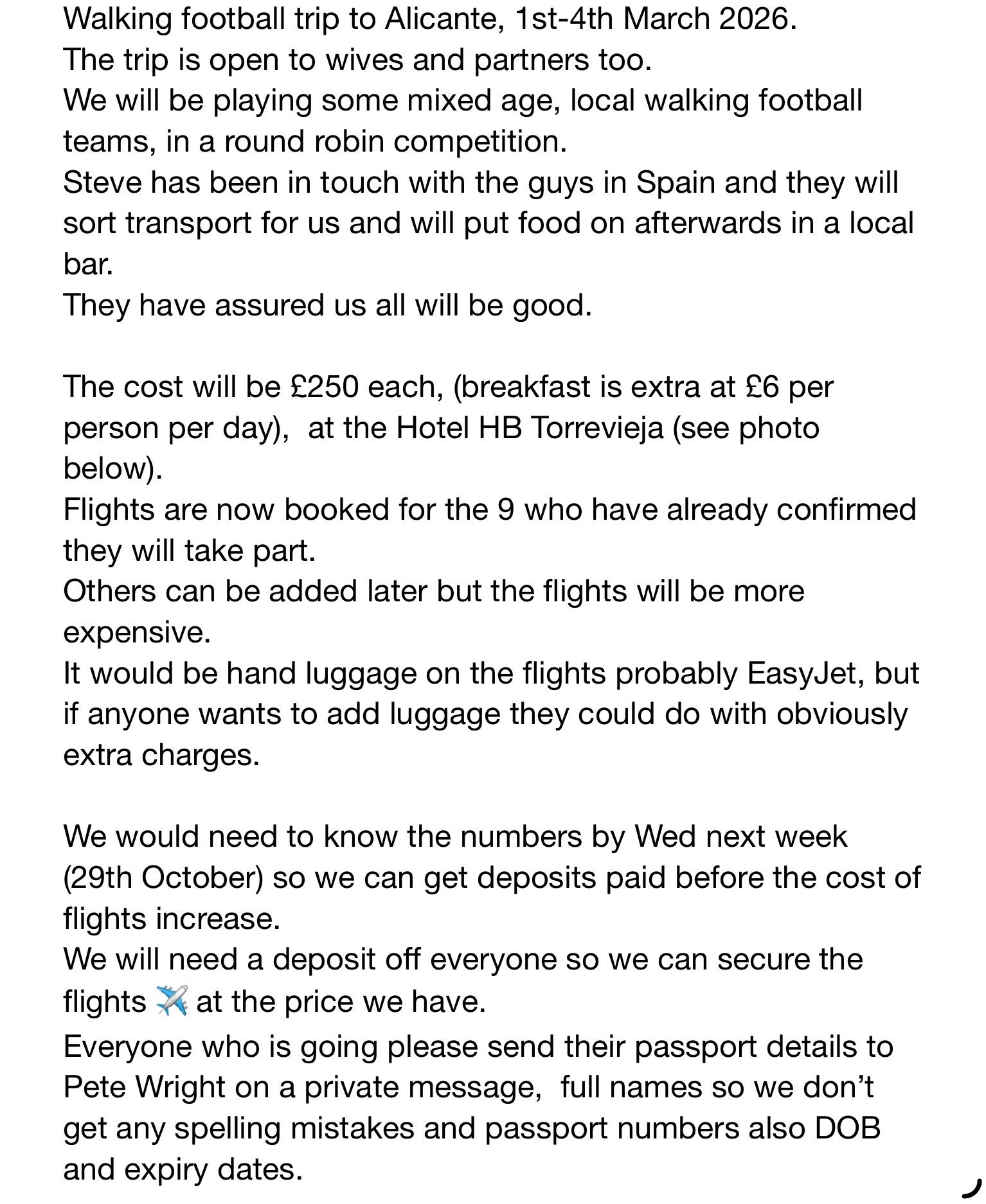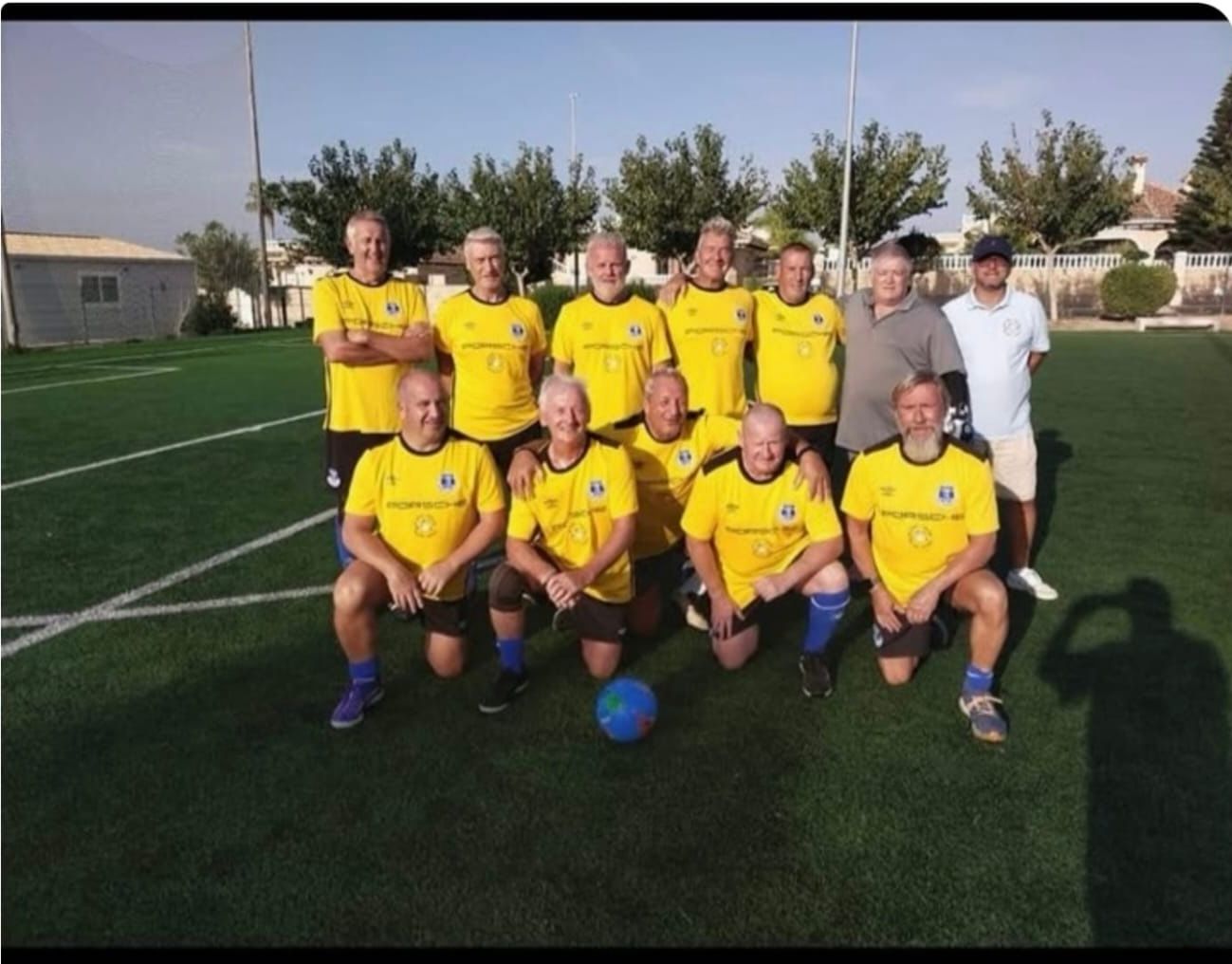News

Welcome to the website for Tameside Striders Denton.
Constructive comments and suggestions are welcome, please use the Contact tab on the menu to submit.
—————————————
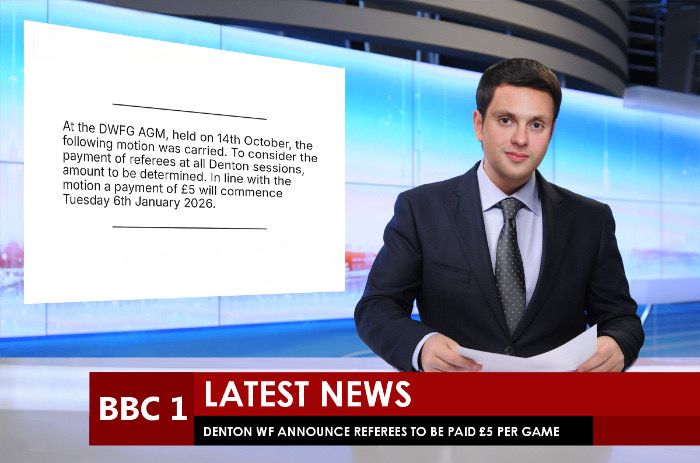
—————————————
*** The teams and fixtures have been announced for the charity game on 29th December
For more information please see ‘Denton WF Yuletide festival for charity’ on the Events page
—————————————
To all our walking footballers at Denton.
We have 4 teams who play competitive walking football at Heywood. 1 x over 65s, 2x over 70s, and 1x over 75s.
All 4 teams play 4/5 games on one day on each of the following months: March, April, May, June, September, October, November, and December. There are no games in January, February, July, and August.
If any of our players who don't currently play for our teams and want to be considered to play in future, please contact me, Colin Fielding 07580088080 or reply to this WhatsApp.
About
Who are we
Tameside Striders is a Walking Football group which meets to play every Tuesday and Thursday throughout the year at DentonYouth F.C. King Street, in Denton.Also known as Denton Walking Football Group.
THIS IS NOT FOOTBALL but a slower, reduced risk derivative aimed at older players for exercise and enjoyment.We are carrying forward the walking football initiative facilitated by Age UK Tameside and although our 'Badgers' form the competitive element at Over 70 level we're primarily concerned with internal games. We will play friendly games with other teams from time to time.The over 70's team were founder members of the Greater Manchester Walking Football League at Heywood Sports Village.
RECRUITMENT NOW LIMTED please check.
We play on our superb synthetic pitch for five hours a week. Tuesday from 10am. it's 'Over 68' hour plus and then from just after eleven am. the 'Unders' get their game. All players are over fifty years of age.
The games are fairly competitive but the ethos of our group is based on enjoyment. Any ego's are left at home and as a mixed ability group we tend to play with smiles on our faces most of the time although foul weather can challenge that. All weather pitch, all weather players.
And though results matter, they are not important. We finish with a cup of tea or coffee (outdoors at the moment) and generally put the world to rights.Men 70 + and 65+, and women over 45 years of age attend our Thursday session imaginatively called 'DENTON THURSDAY' however we try to match abilities and this may result in women attending a different session.
Some sessions are currently playing A.S.K.A.N.C.E. a 'sweeper/keeper and non-contact experience' a novel form of the game using mini goal posts and dispensing with goalkeepers. This is a more technical, precision passing form of walking football and removes some of the power shooting element which a few players prefer. It's great fun for the more proficient player as well as those of lesser ability. Super enjoyment based exercise. An alternative to the conventional walking football format which we re-introduced at some sessions following easing of Covid lockdown restrictions .
When new players turn up at our Tuesday & Thursday sessions they must first fill in a routine basic health screening form which is deposited with the Secretary. The form includes emergency contact details and a disclaimer to acknowledge the signee agrees they are playing the game at their own risk.There can be no exceptions to this rule.
Spaces are now extremely limited, it's regretted that new people cannot just turn up and expect to get a game.Walking Football has caught on all around the country.
We will soon have to introduce a waiting list !
However, if you do want to play with us, do not attend with a highly competitive win-at-all-costs attitude because you'll soon be found out and advised you're in the wrong place.
As stated we play first and foremost for enjoyment. A non-contact measured game. We do not want anyone going home by way of a Hospital. Remember most of us are knocking on a bit so treat opponents and team mates with respect, and with a duty of care.
We always have a short warm up with stretching and limbering up to get bodies attuned to the demands of walking football which can be quite strenuous. Cameras are often around and there may be a team photo and some action shots too. Sometimes we video our games for the group's website. Tongue in cheek match reports help reinforce a feeling of camaraderie and belonging.Performances are NOT criticised. You must be prepared for your photograph and name appearing on our website and social media.
For internal, weekly games players supply their own shirts, shorts and socks (or jog pants/track suit bottoms etc. - any kind or colour of tee shirt will do. Players are supplied with orange and blue reversible ‘bibs' to differentiate between the teams. These are yours to keep, so please bring your bib to every session you attend. Wear Astro trainers designed for Astroturf. NOT FOOTBALL BOOTS.Astro trainers have 'pimpled' soles. They are now compulsory footwear at our sessions.If we play external games against other clubs then we will provide kit, and laundering. The rules we play to are easy to learn. The main one being - NO RUNNING and Non-Contact. 99% of games are Refereed, we have several qualified and accredited officials in our group. Additional sweeper/keeper rules can be found on the relevant page, on this website - check the menu for 'more'.
Constitution
TAMESIDE STRIDERSDenton Walking Football Group CONSTITUTION 2021
Introduction
The name of the group is Tameside Striders Denton Walking Football Group. Established in 2016.The purpose and aim of the group is to facilitate the playing of Walking Football and promote its attendant recognised benefits. In addition to internal recreational games we may sometimes take part in external leagues, tournaments and friendly games at home and away when circumstances permit.
Officers & Management
The Group will be Governed by a Committee consisting of the following officers.Chairman, Secretary, A Treasurer or 2 x Co- Treasurers, plus four other committee members.More than one position may be held by an individual, excepting that of Chairman.The members of the Committee will be elected annually at the AGM by the Group Members. A proposer and a seconder is required in writing for potential replacement committee members.Each member of the group including committee members will have one vote each for each position being elected.In the event of any vote being deadlocked, then the Chairman will have a casting vote.The Executive Committee shall have authority to deal with any matter not expressly covered by the Group Constitution & Rules.
Continuing MembershipGroup membership is renewable annually in the Autumn of each year from a date notified one calendar month in advance.The Group reserves the right to refuse or withdraw membership to any applicant or current member it feels may be detrimental to the Group's activities. (Our Code of Conduct is at the foot of this Constitution).
Meetings
In normal circumstances the A.G.M. will be held in August and an additional players meeting in February of each year.Members must attend these meetings in order to cast any vote.An additional players meeting can be requested by any member submitting a request to the Chairman in writing, along with valid reasons for such a request.Notice of any proposed changes to the Group Constitution & Rules must be given in writing to the General Secretary by the 31st July in any given year, such notice to include the text of any proposed change.Notice of all business to be transacted at the A.G.M. will be given to all members in the form of an agenda at least 7 days prior to the AGM.At each annual A.G.M. the Treasurer or a Co-Treasurer will give a report on the financial state of the group, and a summary of all financial activity since the last meeting. In addition the Treasurer or a Co-Treasurer will report weekly and/or monthly to the other members of the Committee giving a rundown of income and expenditure in the interests of regular transparency. Photocopies of monthly Bank statements will be included whenever possible.
Records
The following records shall be maintained by the Group: -Minutes of Group meetings. Reports from official Executive Committee meetings.Income from sessions ie. players game fees. It is incumbent on the Treasurer or a Co-Treasurer to make these details known to the committee on a weekly basis in normal circumstances.Weekly and Monthly expenditure in connection with sessions - pitch rental & Referees etc.Other Expenditure and income.Addresses of players including email if applicable and phone numbers. Also next of kin details to be contacted in any emergencyA record of disciplinary proceedings and hearings.
New Membership
Any new member wishing to join the Group should ideally attend a session as a spectator first. If male he must be older than sixty years of age. Females over thirty five years are eligible to join. Joining after April 1st. will not attract a membership fee until the Autumn to cover the following season. Registration forms must be fully completed before taking to the pitch.Applications for admission to the Group will be considered by the Committee prior to majority acceptance. As stated previously in the constitution we reserve the right to reject applications on any reasonable grounds.In special circumstances it may be possible for a 'guest' player to join in our session on a 'one off' basis.
General
Members complete a registration form which will be updated from time to time. This form clearly states all taking part in group sessions do so at their own risk.The home pitch/ground shall normally be the Denton Youth F.C. facility at King Street Denton.The Group will endeavour to provide modest accidental injury insurance. We aim to have our defibrillator present at most sessions and there is an additional one inside the building at our home groundOur website hosting costs are paid from general funds. The site is edited by the Secretary at the moment but the content is not limited to his editorial input.The playing rules we adopt are currently Greater Manchester County F.A. rules for walking football as decided and drawn up in consultation with our local F.A. in January 2018. Rules we helped design, although we reserve the right to amend them should the Committee see fit.We are not bound to accept rules emanating from the Walking Football Association or the National F.A.When we play groups (teams) from other Clubs we will agree rules beforehand and proceed as arranged. Referee's decisions are to be accepted by players but any clarification can be sought after games.Playing arrangements will vary from week to week, session to session. We will always endeavour to provide a pleasant playing environment where results matter but are not seen as important. When necessary the committee reserves the right to restrict attendance to one session per week.Attendant players names at all sessions will be recorded on paper, either in an attendance book or by themselves signing a register at the same time as paying their session fees on arrival.Players will be asked to conform with any instructions given by a committee member on a session by session basis. Close adherence to our Code of Conduct' is mandatory and required from everyone who attends King Street 'walking football ' sessions.Cameras and video play a large part in our activities and all players sign an acceptance clause in the registration document. All need to be comfortable for their image to appear online, and elsewhere. Permission for this is clearly given by signing the registration form.
Disciplinary Procedures
When required The Group Committee will convene a Disciplinary Sub- Committee comprised of no less than three committee members to deal with breaches of our code of conduct (see foot of constitution) . A Chairman , who will also act as the Secretary of this committee will be appointed on an ad hoc basis by mutual agreement. Other group members may, at the discretion of the Chairman be authorised to sit on any such committee, should a conflict of interest arise.Matters relating to the conduct of players, supporters and/or team officials can only be dealt with by this Disciplinary Sub-Committee. Such matters will normally be reported directly to the Executive Committee by the match referee or any player who feels it appropriate. Players may be asked to appear before the Sub-Committee. The outcome will be notified to the appropriate party as soon as possible. There will be no right of appeal.No person may sit on a Disciplinary Sub- Committee if they they have a direct interest in the case being discussed. Any doubt on this will be determined by the Group Chairman.Parties will be given written notice of the date and time of the meeting and any letters of defence or mitigation should be sent to the Disciplinary Sub-Committee Chairman at least 48 hours prior to the hearing.If any relevant party fails to attend then the matter may be decided in their absence.The outcome of Disciplinary Hearings will be notified to relevant parties in writing by the Disciplinary Committee Secretary within 7 days of the relevant Disciplinary Hearing.
Appointment of Referees etc.
We have a pool of Referee's and they volunteer to officiate our games on a regular, or irregular basis. Most are F.A. and/or W.F.A. qualified and are expected to keep up with the rules we abide by, and any changes we may introduce. Some are not qualified but carry as much weight as anyone else who offers to Referee a game. The Executive Committee will always support our Referees. We will always try to arrange for a Referee for internal games but this may not always be possible.
CODE OF CONDUCT
This group was established to provide walking football within sensible parameters of competitiveness Results matter but are not important. Exercise and enjoyment is our number one aim for all who attend. We are an inclusive mixed ability group.All playing members should familiarise themselves with this code of conduct.- - - -Any person participating in our sessions at Denton or away from home playing in leagues, tournaments or friendly games agrees to abide by this Code of Conduct.Players at all times should play the game as it is intended to played. A good natured later life bonus for older players. Accept the rules by which we play by. This is not football it is a derivative of the game. Walking football is a risk reduced version of the game we remember playing in days gone by.D.W.F.G. Committee members and your playing partners should be treated with respect at all times. Equipment provided must also be viewed in the same light.- - - - -Recognise that the Referee's decisions are final. No running (includes jogging) on or off the ball. Referee's and any Assistant Referee's must be treated with the utmost respect. As should Denton Youth F.C personnel and their premises.- - - -Accept the ethos of non-contact walking football as defined under the rules by which we play either conventional walking football (Manchester County F.A. Rules for Walking Football) or our own sweeper/keeper variant - see adapted rules print out.- - - -GROUP WARM UPS ARE NOT COMPULSORY: However if you wish to perform your own routine please stay out of the group line up and occupy a quiet corner of the pitch.Never engage in unsporting behaviour, use foul language , gamesmanship, bullying, violence or aggressive behaviour all of which will be liable to have negative consequences on your membership of our group.PROMOTE AND ENDORSE A SENSE OF PERSPECTIVE TOWARDS RESULTS AND PERFORMANCES OF YOUR OWN AND OF OTHERS. FAIR PLAY and a FRIENDLY SPIRIT IS PARAMOUNT ! THANK YOU.
Constitution
TAMESIDE STRIDERSDenton Walking Football Group CONSTITUTION 2021
Introduction
The name of the group is Tameside Striders Denton Walking Football Group. Established in 2016.The purpose and aim of the group is to facilitate the playing of Walking Football and promote its attendant recognised benefits. In addition to internal recreational games we may sometimes take part in external leagues, tournaments and friendly games at home and away when circumstances permit.
Officers & Management
The Group will be Governed by a Committee consisting of the following officers.Chairman, Secretary, A Treasurer or 2 x Co- Treasurers, plus four other committee members.More than one position may be held by an individual, excepting that of Chairman.The members of the Committee will be elected annually at the AGM by the Group Members. A proposer and a seconder is required in writing for potential replacement committee members.Each member of the group including committee members will have one vote each for each position being elected.In the event of any vote being deadlocked, then the Chairman will have a casting vote.The Executive Committee shall have authority to deal with any matter not expressly covered by the Group Constitution & Rules.
Continuing MembershipGroup membership is renewable annually in the Autumn of each year from a date notified one calendar month in advance.The Group reserves the right to refuse or withdraw membership to any applicant or current member it feels may be detrimental to the Group's activities. (Our Code of Conduct is at the foot of this Constitution).
Meetings
In normal circumstances the A.G.M. will be held in August and an additional players meeting in February of each year.Members must attend these meetings in order to cast any vote.An additional players meeting can be requested by any member submitting a request to the Chairman in writing, along with valid reasons for such a request.Notice of any proposed changes to the Group Constitution & Rules must be given in writing to the General Secretary by the 31st July in any given year, such notice to include the text of any proposed change.Notice of all business to be transacted at the A.G.M. will be given to all members in the form of an agenda at least 7 days prior to the AGM.At each annual A.G.M. the Treasurer or a Co-Treasurer will give a report on the financial state of the group, and a summary of all financial activity since the last meeting. In addition the Treasurer or a Co-Treasurer will report weekly and/or monthly to the other members of the Committee giving a rundown of income and expenditure in the interests of regular transparency. Photocopies of monthly Bank statements will be included whenever possible.
Records
The following records shall be maintained by the Group: -Minutes of Group meetings. Reports from official Executive Committee meetings.Income from sessions ie. players game fees. It is incumbent on the Treasurer or a Co-Treasurer to make these details known to the committee on a weekly basis in normal circumstances.Weekly and Monthly expenditure in connection with sessions - pitch rental & Referees etc.Other Expenditure and income.Addresses of players including email if applicable and phone numbers. Also next of kin details to be contacted in any emergencyA record of disciplinary proceedings and hearings.
New Membership
Any new member wishing to join the Group should ideally attend a session as a spectator first. If male he must be older than sixty years of age. Females over thirty five years are eligible to join. Joining after April 1st. will not attract a membership fee until the Autumn to cover the following season. Registration forms must be fully completed before taking to the pitch.Applications for admission to the Group will be considered by the Committee prior to majority acceptance. As stated previously in the constitution we reserve the right to reject applications on any reasonable grounds.In special circumstances it may be possible for a 'guest' player to join in our session on a 'one off' basis.
General
Members complete a registration form which will be updated from time to time. This form clearly states all taking part in group sessions do so at their own risk.The home pitch/ground shall normally be the Denton Youth F.C. facility at King Street Denton.The Group will endeavour to provide modest accidental injury insurance. We aim to have our defibrillator present at most sessions and there is an additional one inside the building at our home groundOur website hosting costs are paid from general funds. The site is edited by the Secretary at the moment but the content is not limited to his editorial input.The playing rules we adopt are currently Greater Manchester County F.A. rules for walking football as decided and drawn up in consultation with our local F.A. in January 2018. Rules we helped design, although we reserve the right to amend them should the Committee see fit.We are not bound to accept rules emanating from the Walking Football Association or the National F.A.When we play groups (teams) from other Clubs we will agree rules beforehand and proceed as arranged. Referee's decisions are to be accepted by players but any clarification can be sought after games.Playing arrangements will vary from week to week, session to session. We will always endeavour to provide a pleasant playing environment where results matter but are not seen as important. When necessary the committee reserves the right to restrict attendance to one session per week.Attendant players names at all sessions will be recorded on paper, either in an attendance book or by themselves signing a register at the same time as paying their session fees on arrival.Players will be asked to conform with any instructions given by a committee member on a session by session basis. Close adherence to our Code of Conduct' is mandatory and required from everyone who attends King Street 'walking football ' sessions.Cameras and video play a large part in our activities and all players sign an acceptance clause in the registration document. All need to be comfortable for their image to appear online, and elsewhere. Permission for this is clearly given by signing the registration form.
Disciplinary Procedures
When required The Group Committee will convene a Disciplinary Sub- Committee comprised of no less than three committee members to deal with breaches of our code of conduct (see foot of constitution) . A Chairman , who will also act as the Secretary of this committee will be appointed on an ad hoc basis by mutual agreement. Other group members may, at the discretion of the Chairman be authorised to sit on any such committee, should a conflict of interest arise.Matters relating to the conduct of players, supporters and/or team officials can only be dealt with by this Disciplinary Sub-Committee. Such matters will normally be reported directly to the Executive Committee by the match referee or any player who feels it appropriate. Players may be asked to appear before the Sub-Committee. The outcome will be notified to the appropriate party as soon as possible. There will be no right of appeal.No person may sit on a Disciplinary Sub- Committee if they they have a direct interest in the case being discussed. Any doubt on this will be determined by the Group Chairman.Parties will be given written notice of the date and time of the meeting and any letters of defence or mitigation should be sent to the Disciplinary Sub-Committee Chairman at least 48 hours prior to the hearing.If any relevant party fails to attend then the matter may be decided in their absence.The outcome of Disciplinary Hearings will be notified to relevant parties in writing by the Disciplinary Committee Secretary within 7 days of the relevant Disciplinary Hearing.
Appointment of Referees etc.
We have a pool of Referee's and they volunteer to officiate our games on a regular, or irregular basis. Most are F.A. and/or W.F.A. qualified and are expected to keep up with the rules we abide by, and any changes we may introduce. Some are not qualified but carry as much weight as anyone else who offers to Referee a game. The Executive Committee will always support our Referees. We will always try to arrange for a Referee for internal games but this may not always be possible.
CODE OF CONDUCT
This group was established to provide walking football within sensible parameters of competitiveness Results matter but are not important. Exercise and enjoyment is our number one aim for all who attend. We are an inclusive mixed ability group.All playing members should familiarise themselves with this code of conduct.- - - -Any person participating in our sessions at Denton or away from home playing in leagues, tournaments or friendly games agrees to abide by this Code of Conduct.Players at all times should play the game as it is intended to played. A good natured later life bonus for older players. Accept the rules by which we play by. This is not football it is a derivative of the game. Walking football is a risk reduced version of the game we remember playing in days gone by.D.W.F.G. Committee members and your playing partners should be treated with respect at all times. Equipment provided must also be viewed in the same light.- - - - -Recognise that the Referee's decisions are final. No running (includes jogging) on or off the ball. Referee's and any Assistant Referee's must be treated with the utmost respect. As should Denton Youth F.C personnel and their premises.- - - -Accept the ethos of non-contact walking football as defined under the rules by which we play either conventional walking football (Manchester County F.A. Rules for Walking Football) or our own sweeper/keeper variant - see adapted rules print out.- - - -GROUP WARM UPS ARE NOT COMPULSORY: However if you wish to perform your own routine please stay out of the group line up and occupy a quiet corner of the pitch.Never engage in unsporting behaviour, use foul language , gamesmanship, bullying, violence or aggressive behaviour all of which will be liable to have negative consequences on your membership of our group.PROMOTE AND ENDORSE A SENSE OF PERSPECTIVE TOWARDS RESULTS AND PERFORMANCES OF YOUR OWN AND OF OTHERS. FAIR PLAY and a FRIENDLY SPIRIT IS PARAMOUNT ! THANK YOU.
Sessions
Alan Richards
Session 10am Tuesday
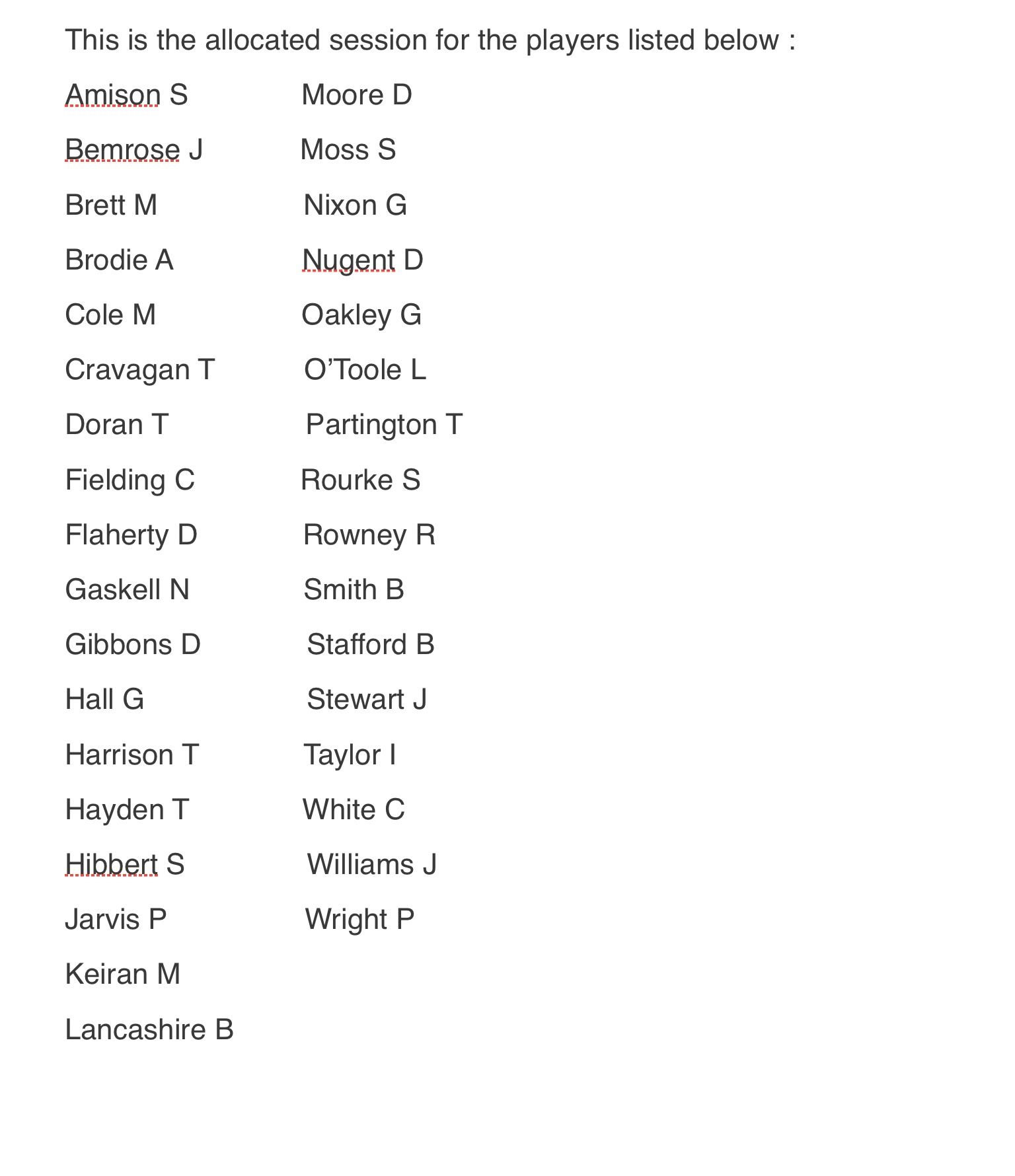
Session 11am Tuesday

Session 10am Thursday
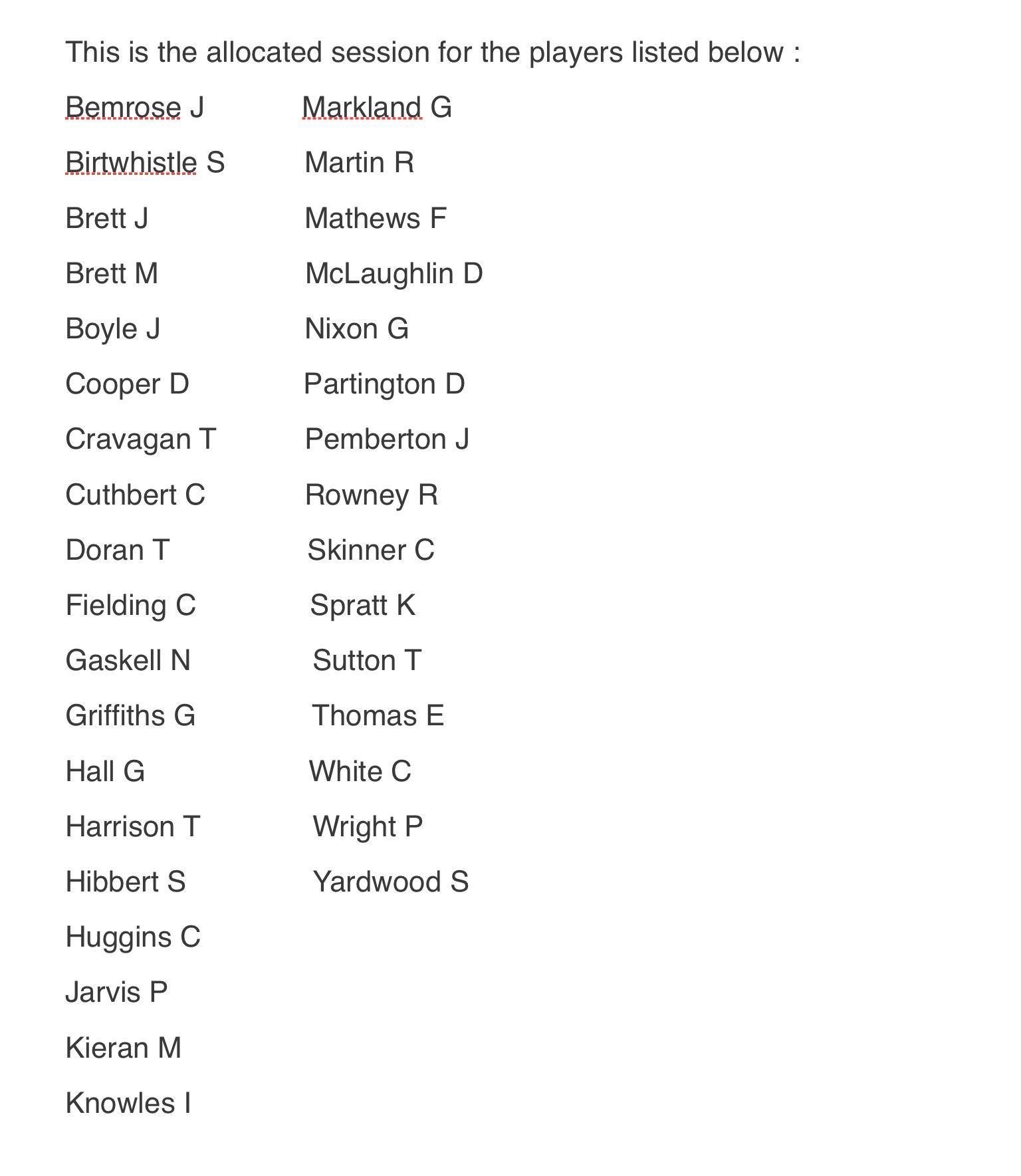
Session 11am Thursday
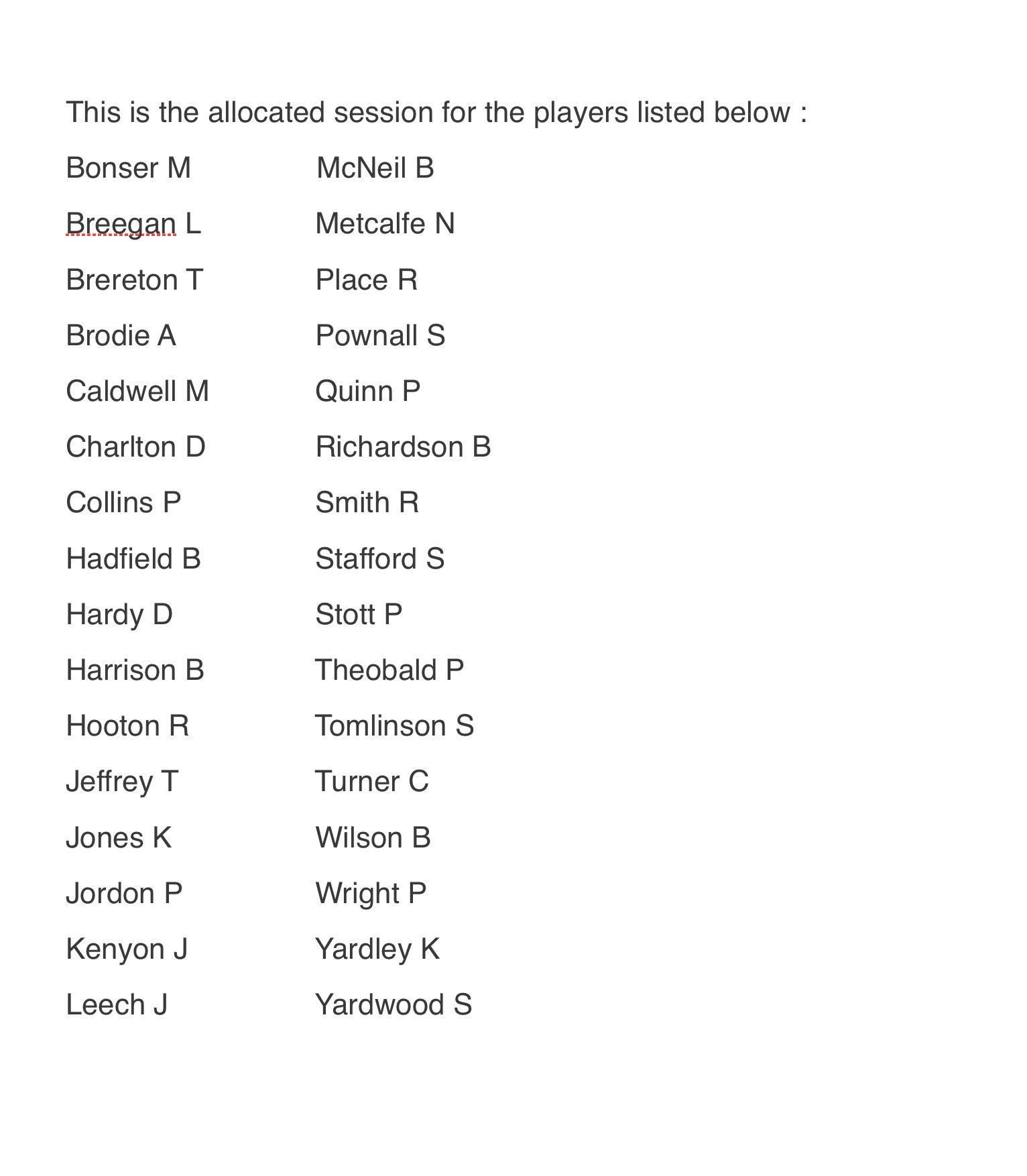
Sweeper keeper
DWFG 'Sweeper Keeper' - an introduction
PLAYED WITH A SIZE FOUR BALL 'SWEEPER / KEEPER is an alternative form of walking football. Rules are devised in the main by Alan Richards and Tony Cravagan.
The name of the game came from Colin Fielding.
Normal walking football under Manchester County F.A. rules apply in terms of non-contact and not running. Restarts of play (corner kicks the exception here) , indirect free kicks (wait for the whistle) , height restrictions etc.
Here at Denton, four team offences equals a penalty etc.
The offences include an accumulation of running and contact.
The game reduces the power element replacing it with precision and more awareness of positional play.
It removes the urge to shoot for goal with maximum power at every opportunity. Goals may be scored from anywhere on the pitch but not from the defensive 'D' area. By using miniature goals of good quality, there is no need for a goalkeeper – often the most injury prone position on the pitch in the conventional game.Ideally the format is five versus five or four versus four. Three v three is possible but can be hard work. Pitch sizes should be reduced accordingly. Higher numbers are possible, and can be enjoyable with extended pitches. Our maximum at King Street is eight versus eight. Flexibility is determined by the available space.
RULES for THREE TOUCH 'SWEEPER/KEEPER' September 2020:
Note: The term "Goal kick" covers up to a three touch process from the Sweeper/Keeper hereafter referred to as the 'SK'.
1. In front of the goals a 'D' is marked out with a 7 metre radius taken from the centre of the goals. For the largest of pitches sizes of 'D's' can be somewhat larger at the Referee's discretion.
2. Each team nominates their 'SK' and informs the referee of their nominated 'SK' which can change during the game but the Referee must be notified at every change. The 'SK' cannot use his hands to play the ball at any time.
3. A goal may be scored from anywhere within the area of play outside the 'D' area.
4. Any ball crossing the goal line is deemed a Dead Ball except when a goal is scored. (See rule 5a for goal kick procedure.)
4a) When the ball goes behind the defensive goal line having last touched a player from the defending team ('SK' included) an 'advantage kick-in' will be awarded instead of a traditional corner kick. This 'Advantage kick in' must be taken in line with the apex of the 'D' on the side of the goal the ball left the field of play. A goal may not be scored directly from an 'advantage kick in' nor deflected into the goal off a player of the opposing team. In this case a goal kick will restart play.
5. The 'SK' is the only player allowed to enter the 'D' under the following conditions :
5a) To restart play with a goal kick by clearly 'planting' the ball in the 'D' with his foot at ANY point in the area and taking up to 3 subsequent touches in the process , which means he can walk out with the ball or play a pass from within the 'D' before exiting.
5b) The 'SK' must then leave the 'D' immediately the ball is in play.
5c) Should a ball strike the 'SK' when walking out of the 'D' play will continue even if this prevents a goal. However if the Referee decides this is a deliberate attempt to block or deflect the ball a penalty kick may be awarded. This deliberate action could also result in further action from the Referee.d) The SK may kick the ball into the 'D' during play to relieve pressure upon himself. e) The 'SK' can follow the ball into the 'D' if it is kicked into the area by his own player, or an opponent.
6. With the above exceptions any player defender or attacker entering the D seeking to gain an advantage (other than momentum or accidentally as a result of contact) will result in a penalty being awarded to the opposing team.
7.Penalty kicks will normally be taken from a central position 7 metres from the apex of the 'D' whatever size the 'D' is. In normal circumstances a total distance of 14 metres. All players , including the defending 'SK' must position themselves behind the ball at least three metres away from the kicker.
7a). Penalty takers are not limited to just one step. There is no step count but they must walk up to the ball. The ball must be allowed to run its course. When the ball stops travelling it is considered 'dead' wherever it settles, if a goal is not scored then a goal kick is taken to restart play as per rule 5a).
7b).Prevention of a clear goal scoring opportunity: When this occurs cynically by foul play such as deliberate handball by the SK or any other player, or by illegal contact on the attacking player, a penalty may be awarded to the attacking team. Reckless and excessively forceful challenges are already covered by the Manchester County F.A. rules.
8. A goal scored from the three touch goal- kick process is not allowed and will not stand, even if it is deflected off an opponent . Play will recommence with a goal kick from the other end.
9. Furthermore and to clarify : a goal cannot be scored directly from the three touch goal kick procedure or from a kick in, or an 'advantage kick in'.
10. Three running offences from a team will result in the award of a penalty to the opposition.
Summing up Sweeper /Keeper….
A more technical game than regular walking football especially suited to older players and younger ones seeking to improve their passing skills. Players must seek to find a channel to goal which they can take advantage of. Inter passing movement can open up these channels leaving the mini goals vulnerable to an attempted strike. Players can shoot, but the level of accuracy required from distance usually favours a stroked ball . A medium to long range 'passing shot'.
There is no restriction on where the ball is struck from and if a channel is seen from much further back then a more powerful ‘shot’ will be needed and these can succeed with some spectacular results.The intention of the game is to improve passing precision and movement. There seems to be much fewer cases of running and contact has been low. Scoreline’s are often close. Some players master the 'SK' role very quickly and perform it well. Making chances hard to come by and posing a creative challenge for attackers.
This game is every bit as demanding on the players and offers levels of exercise that compare well with the normal game.
Profiles
Our committee
Our referees
Our players
Mike Brett
Age 76, Married to Frances, 3 brothers, 4 sisters. Son Paul & daughter Claire 3 grandsons, Luis, Lukas and Logan Played on left wing, till 28. Played fullback & sweeper from 29 to 42. Season ticket holder at MUFC and a big speedway fan Memorable moment. Winning Bank of Ireland 5-A-Side tournament at Broughton Park with my 3 brothers.
David Moore
Married to Frances with two daughters. Formerly a Sub-Postmaster and newsagent In Glossop. Joined the group when it was first invented/introduced in Hadfield by customers Mick and Steve Owen. Despite not playing since student days I’ve gradually learned the game and what I lack in skill I make up for in enthusiasm Born in Leeds, I still regularly attend matches at Elland road.
Laurie O’Toole
Widowed, married for 46 years. 2 children Mark and Louise, 3 Grandchildren William, Charlotte and Lawrence. Job before retirement - Marketing Director for 26 Years. Previous Clubs Fernlea Boys Ashton Utd Ringwood City (Australia) Mooroolbark (Australia) An Everton fan.
Steve Pownall (never Steven !)
Married 39 years to Michele, 3 talented daughters- Siobhan, Francesca and Olivia. 2 grandkids Noah and Aida Primrose, aged 5 & 3. 1 step grandson Jacob. Taxi driver for 30 odd years. Played all positions but best as goalkeeper, playing up to semi-pro level. Managed many a team, winning many trophies. Avid Barcelona FC fan and Belle Vue speedway. Striders own Delboy !
Keith Yardley
Aged 72, married to Carol, one daughter Caroline. Last job before retirement - software engineer at The Coop Bank & Coop Insurance. Played LW or midfield in my younger days. Played WF since 2018. A United fan, born in Salford.
Gallery
Photos
Tiger feet - Hyde 2021
Our annual WF tournament played at Hyde United football ground.
Tiger feet - Hyde 2023
Our annual WF tournament played at Hyde United football ground.
Tiger feet - Hyde 23/07/2025
Our annual WF tournament played at Hyde United football ground.
Floodlights - Denton 2024
Annual charity competition under Denton WF floodlights
Mahal Denton 31/07/2025
Footgolf - Burnage golf club 06/08/2025
Istanbul Grill Denton - 25/09/2025
Curzon night - Curzon Ashton 17/10/2025
Mahal Denton 27/11/2025
King street Denton - random footage 2025
Strider’s Xmas do - Denton golf club 11/12/2025
Videos
Events
GMWF League Heywood
AGM minutes
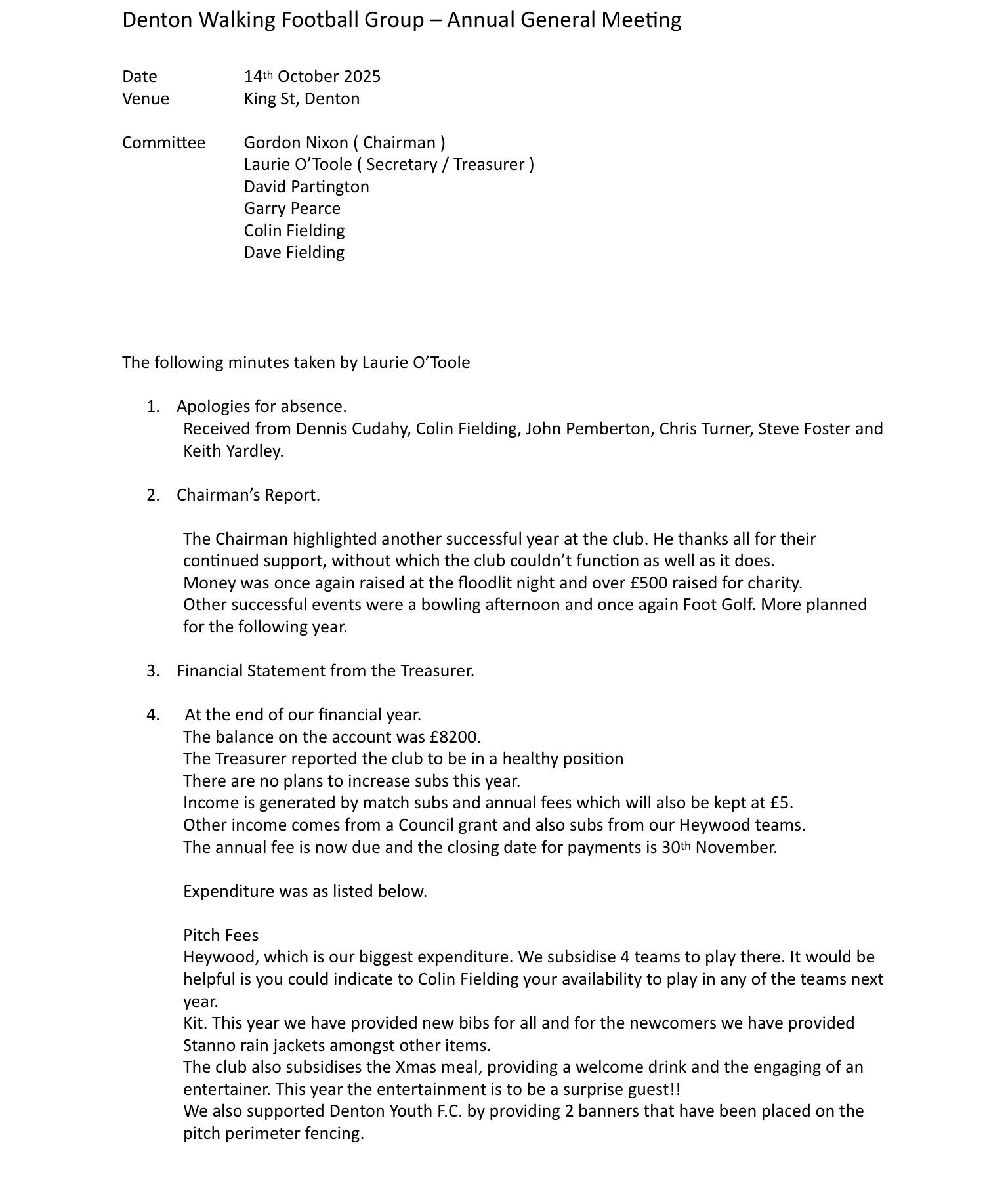

GMWF
Over 65’s Division 2
Season over
Over 70’s Division 1
Season over
Over 70’s Division 3
Season over
Over 75’s Division 1
Season over
Over 65’s Division two
Thursday 27th November 2025
Squad
Les Breegan
Phil Stock
Brian McNeil
Steve Wingrove
Garry Hall
Paul Theobald
Steve Pownall
Captains report
Good day for the 65s at Heywood today, first game was a 0-0 draw settled us in or so we thought lost 2:0 to Moston in the second game hard done to should have had a penalty Gary was tackled from behind when about to shoot thankfully we put it behind us and won the next game 1-0 Theo really had his shooting boots on, in the last game we played Curzon went into a 2-0 lead courtesy of a Theo double unfortunately Curzon got one back for a 2-1 win for striders got to mention one particular save of many by Steve diving full length to his left to push i round the post, well played all of us great day, another mention to Phil Stock and Brian Mcneil neither had kicked a ball fo weeks!
Results & league table
Final table
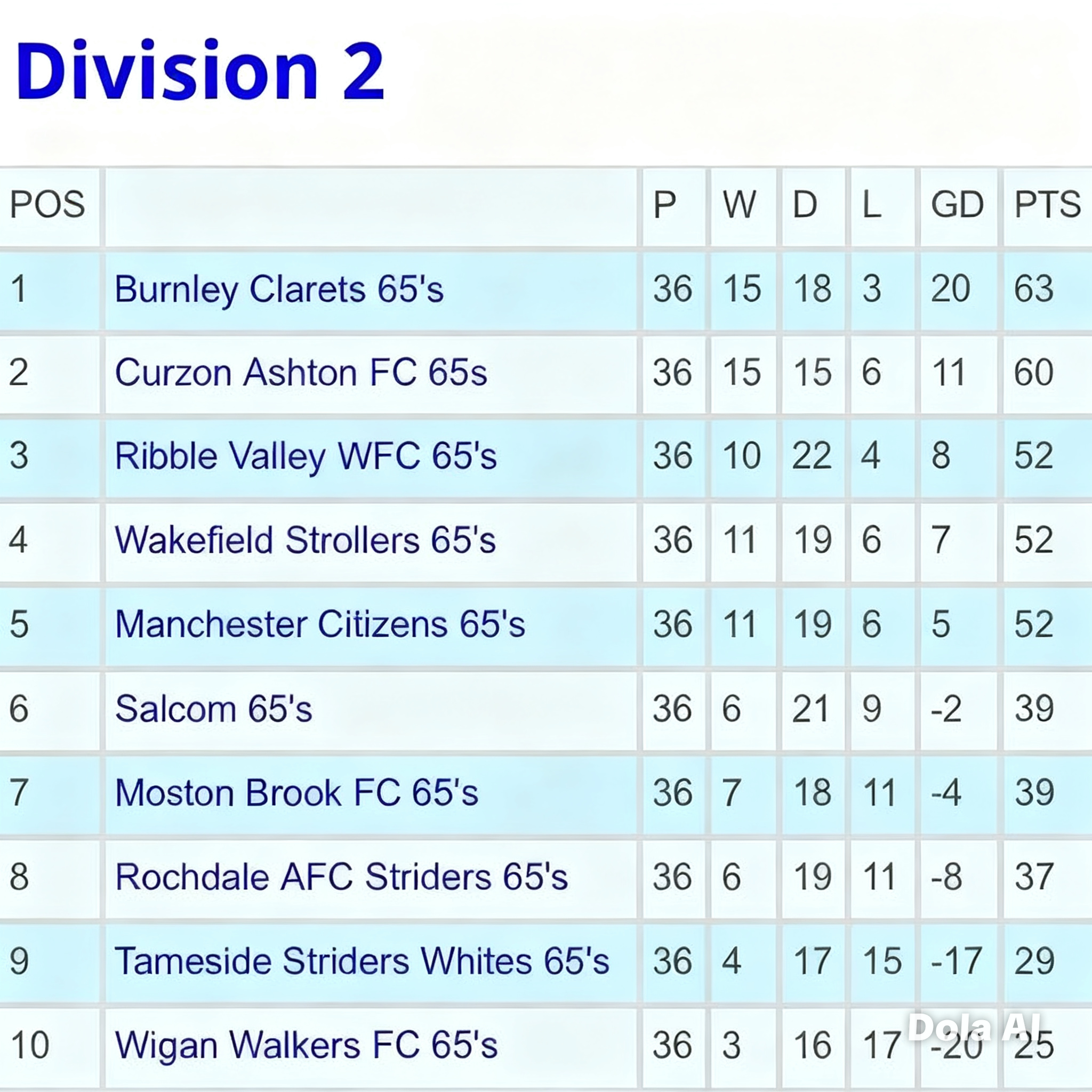
https://manchesterwalkingfootball.uk/fixtures-results-tables/over-65s-league/
Over 70’s Division one
Wednesday 3rd December 2025
Squad
Terry Hayden
John Leech
Colin Fielding
Brian Hadfield
Rob Rowney
Les Breegan
Pete Jarvis
Manager’s report - Colin Fielding
Tameside Striders BLUES played their final 4 league games of this season and needed to do well to avoid relegation. The bottom 2 teams are relegated to Division 2, and there are only 5 teams in the league. At the start of the day we were in 3rd place, 2 points ahead of Winstanley Walkers, who were heading towards relegation with Rochdale.
We drew 0-0 in our first game against Rochdale and drew 0-0 in our 2nd game against Winstanley Walkers, so league positions were the same with 2 games to play.
However, we lost our next game to Bury Relics, and Winstanley won their next game against Rochdale, which put Winstanley above us and put us in the relegation place.
We only had 1 game to play, and that was against Corinthians who needed to win to win the league, and we needed to win to avoid relegation. It was a great game. We defended well, with Brian H, John L and Colin F defending well, and Terry H outstanding in goal. Les B and Rob R were excellent and always a danger to Corinthians . It didn't take long for Rob to leave their defenders in his wake before he smashed the ball into their net. The game finished as 1-0 win for Striders. The last 3 results against Corinthians have been wins for Striders. A great result putting us ahead of Winstanley.
Winstanley had 1 more game to play against Bury. If they won that game they would overtake us in the league if they drew. It may go to goal difference.Bury played well, and it wasn't long before they went ahead 1-0. Winstanly fought hard and played well, but time was ticking away. Finally, Winstanley were awarded a penalty with the last kick of the match and last kick of the season. The goalkeeper saved the penalty, and Winstanley lost 0-1. Winstanley were relegated and Striders are looking forward for another's season in Division 1.
What a day. Well played Striders, a great day's work.
Results & league table
Final table
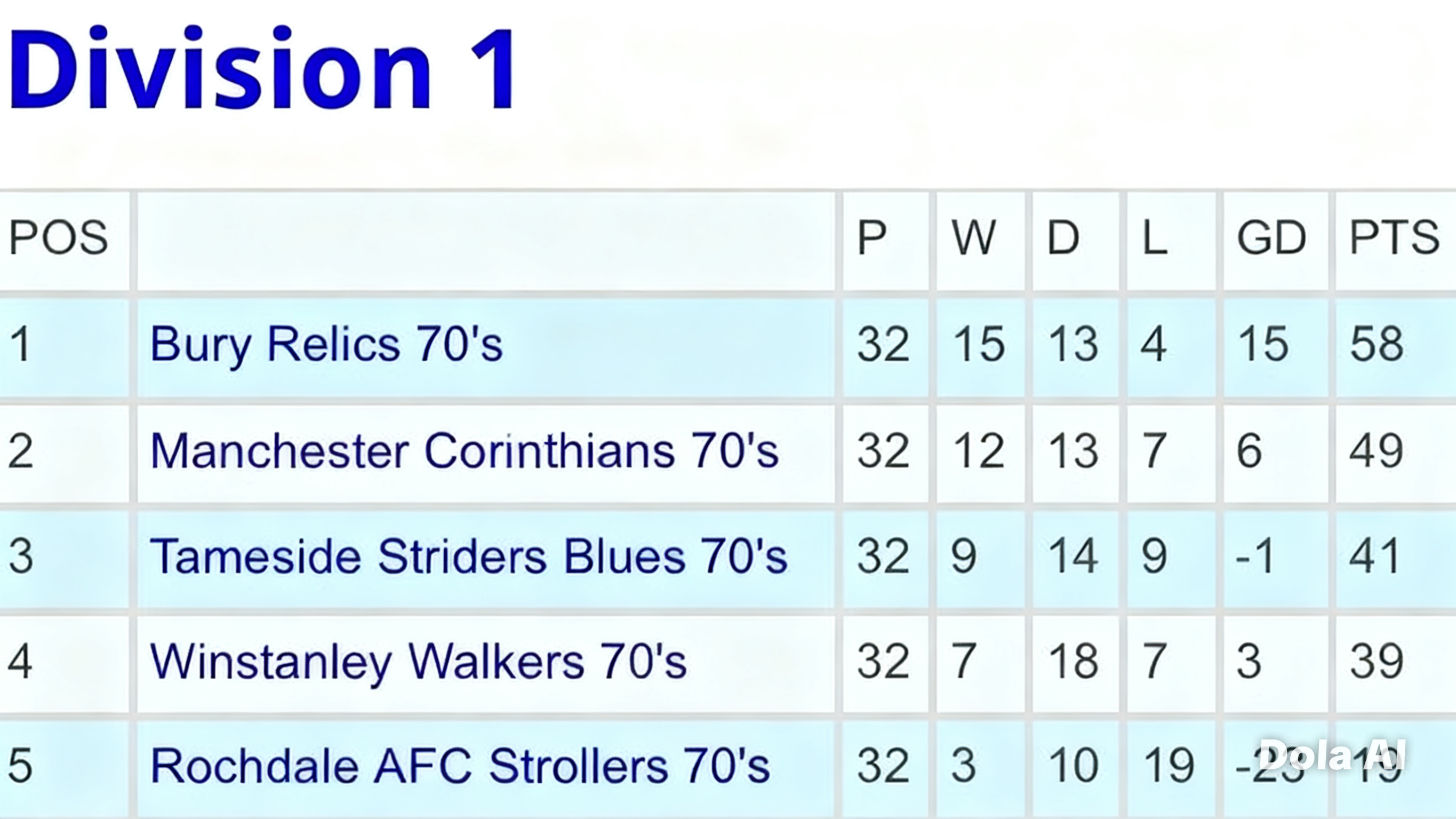
https://manchesterwalkingfootball.uk/fixtures-results-tables/over-70s-league/
Over 70’s Division three
Wednesday 17th December 2025
Squad
Mike Brett
Martyn Heath
Gerry Markland
Pete Smith
Steve Moss
Nigel Metcalfe
Manager’s report
Last round at Heywood, just the 6 today, so thanks to Steve Moss, Martyn Heath and Pete Smith for helping out. Game 1. Lost 0-1 to Rochdale, with Terry scoring with the only shot they had, played some great football but Rochdale keeper had an inspired game.Game 2 won 1-0 against our bogie team Bolton. It was a great own goal.Game 3 0-0 against Panthers, who were promoted. Great game of football, got a little feisty at times. Great save by Nigel to secure the point.Game 4. Lost 1-2 to Ribble who won the league. Started badly, sloppy play at the back gave them a goal in the first 2 minutes. Nip and tuck, then they scored from a corner routine. Nigel again pulled off a great save. Then Steve Moss scored a great goal to give Ribble a nervy last few minutes.
A huge thank you to all striders personnel who have played for the Greens this year, helping us to put a team on the pitch each month. No trophies but lots of enjoyment. If I don't see any of you before the break, all the best for Xmas.
Results & league table
Final table
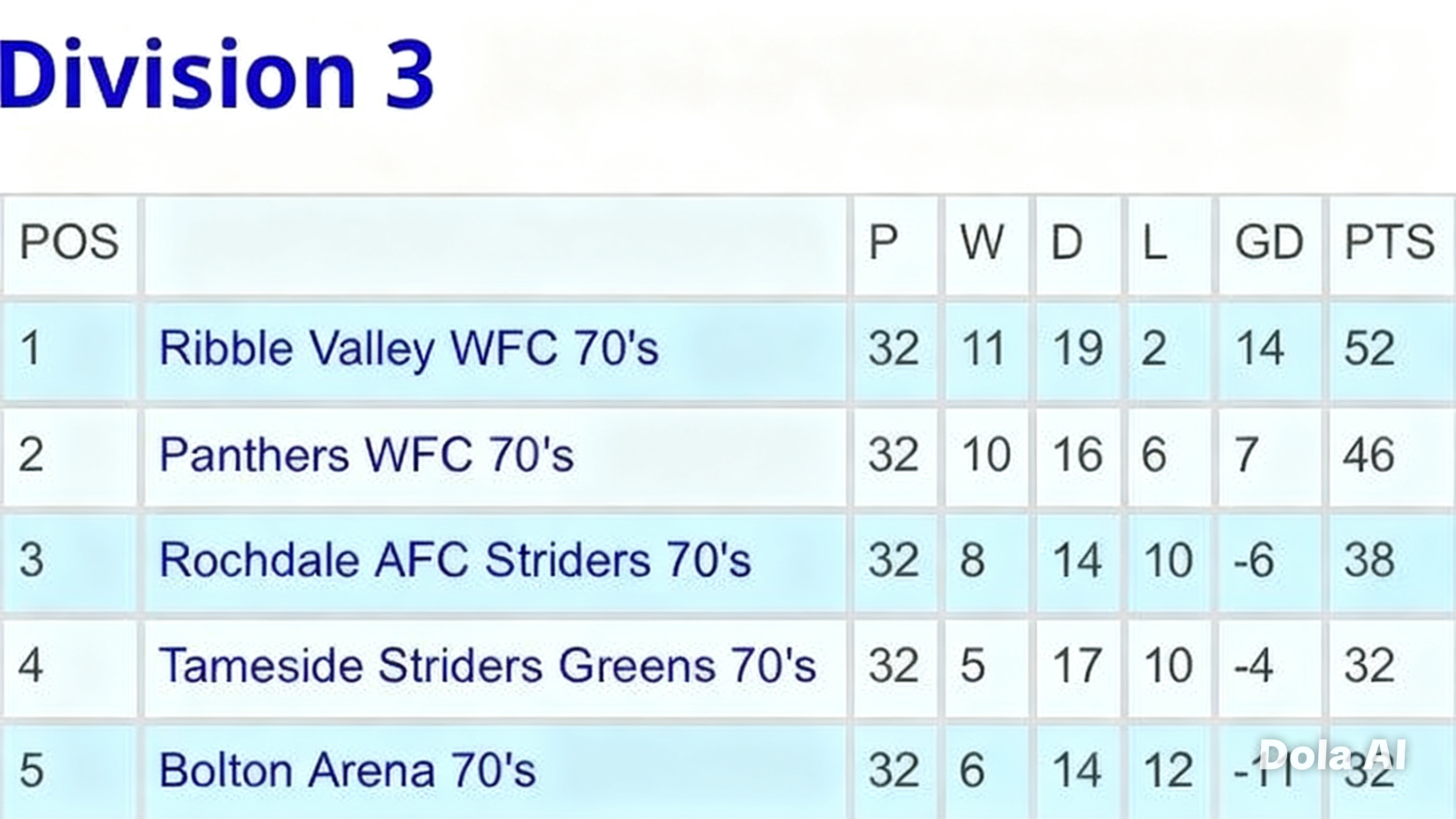
https://manchesterwalkingfootball.uk/fixtures-results-tables/over-70s-league/
Over 75’s Division One
Wednesday 26th November 2025
Squad
Colin Fielding
Terry Hayden
Mike Brett
Pete Jarvis
Terry Harrison
Colin Cuthbert
Rob Rowney
Manager’s report
Today, our guys went to Heywood to play the last few games of this season in the over 75s league. (The only over 75s league in the country)
We played Rochdale in our first game and started poorly, we conceded two goals in the first 5 minutes. We got back in the game when a shot from Mike Brett took a deflection and flew past their keeper. We fought hard and had chances to equalise but didn't, and the result was a 2-1 win to Rochdale.
The next game was against 'The Invincibles ', always a tough game. We played well, dominated the play, and created several chances. Rob Rowney scored his usual goal. However, several other chances were not finished. We were happy with a 1-0 win.
The next game was against League Champions 'Bury Relics. It was a hard fought game with good football played by both teams. A 0-0 result was a fair result.
We finished 3rd in the league, just missing out on the trophies. Thanks to all the guys who played today and all season. Well done, everyone.Terry Hayden Pete Jarvis Colin Fielding Mike Brett Rob Rowney Colin Cuthbert
Results & league table
Final table
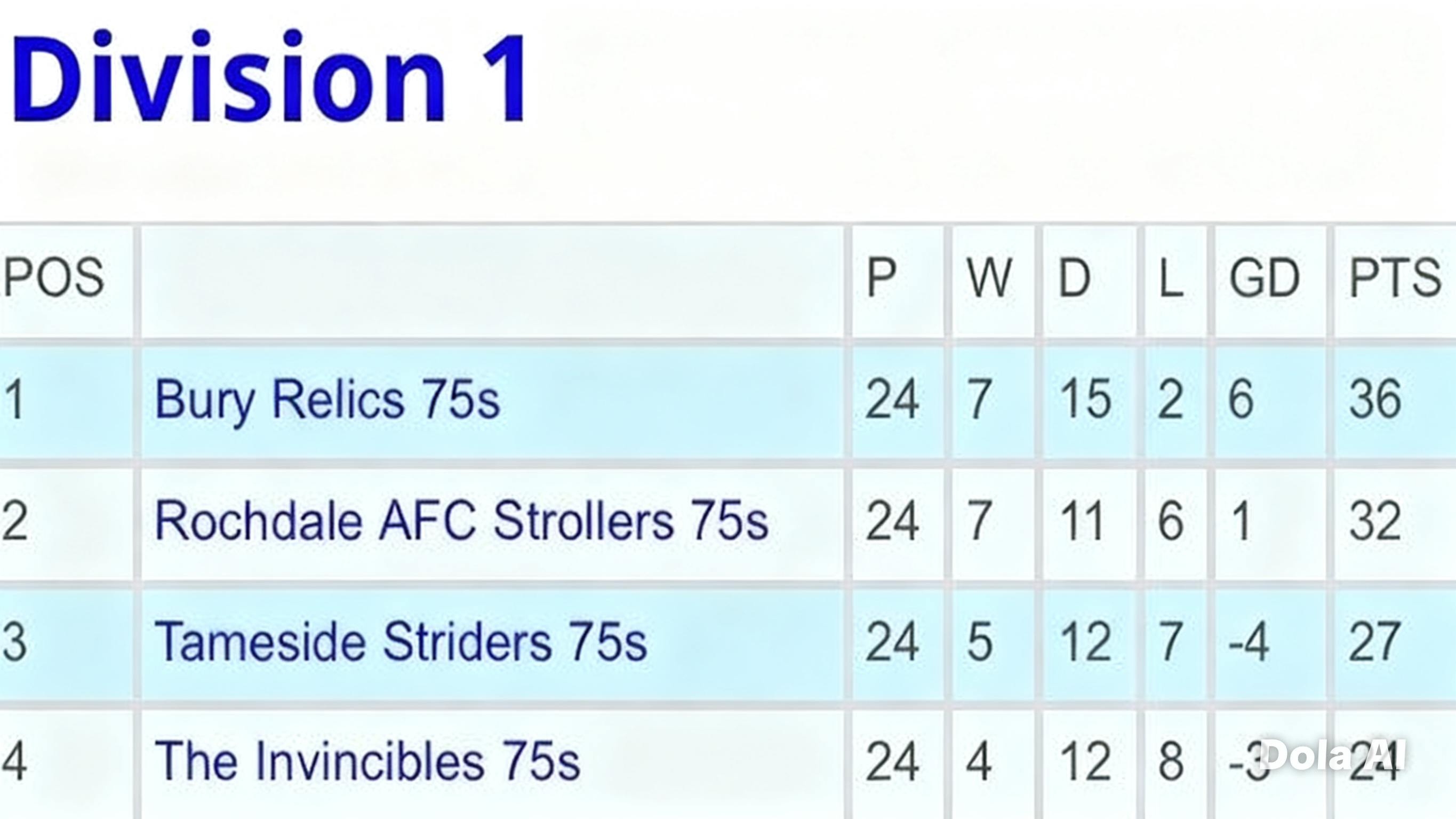
https://manchesterwalkingfootball.uk/fixtures-results-tables/over-75s-league/
Alicante trip
Santa dash
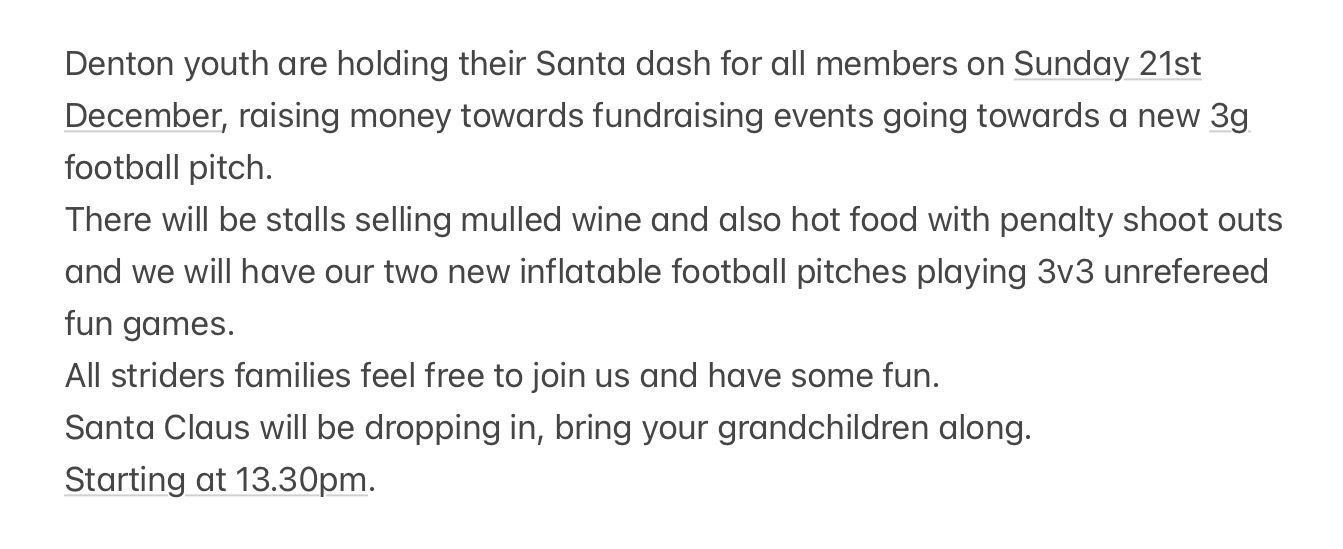
Xmas Charity game
Kick off is at ten and we'd like you all to be there before so we can organise who's playing who.
£5 pounds per player and a Yuletide trophy for the winner 🏆
We'll be having a football card too, £2 a team , £80 for the winner
Optional donation of extra £2 on the card to allow £80 to a player and £80 to the club for the appreciation of the officials or whatever the players decide on the day.
It is planned that the little girl concerned and her family will be present and the youngster will present the trophy to the winning team.
We have limited the number of players to 42
Teams are as below :
*** Graham Oakley will replace the injured Chris Turner in Greens United.
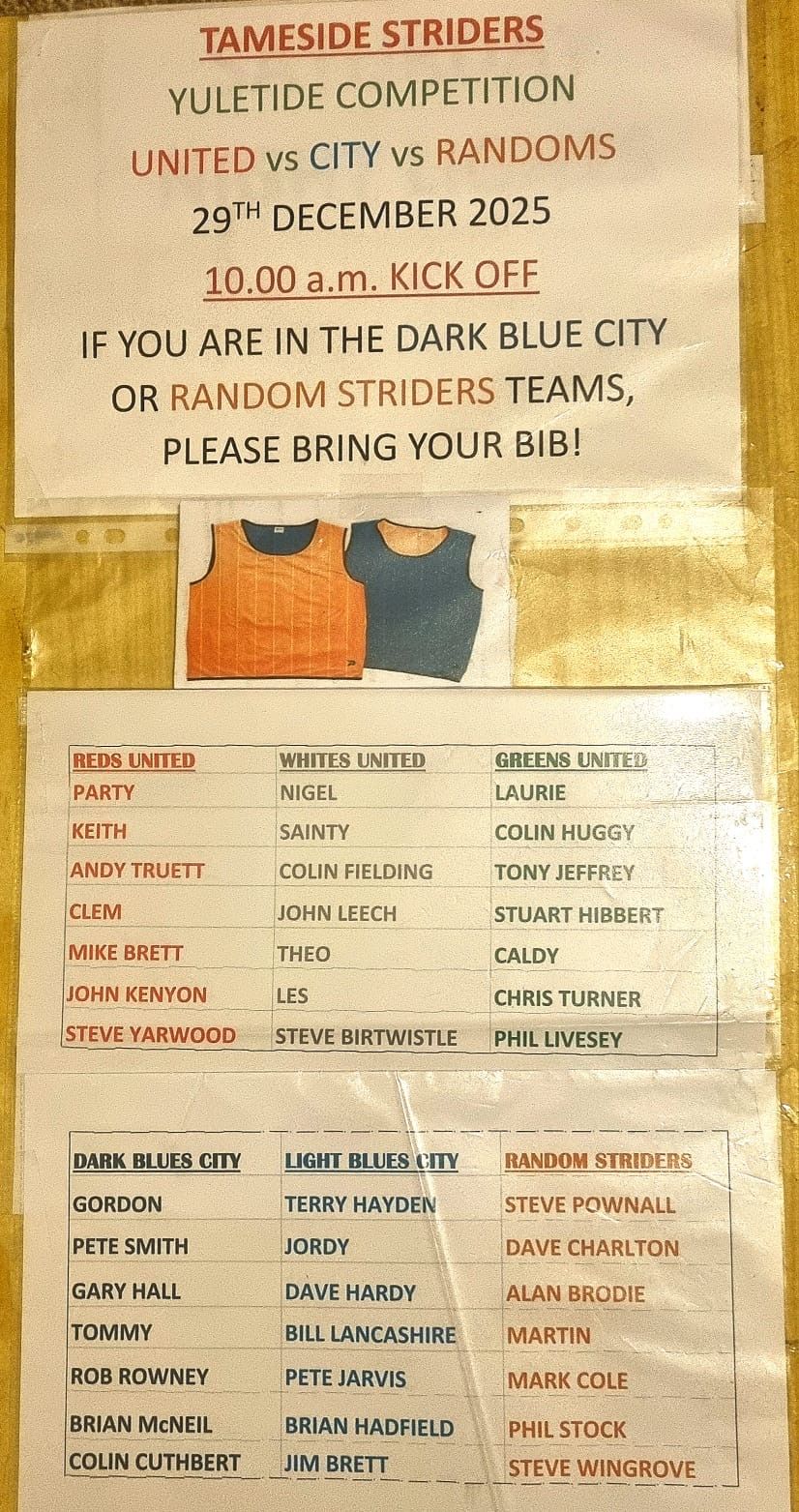

Contact
- King St, Denton, Manchester M34 6HE
